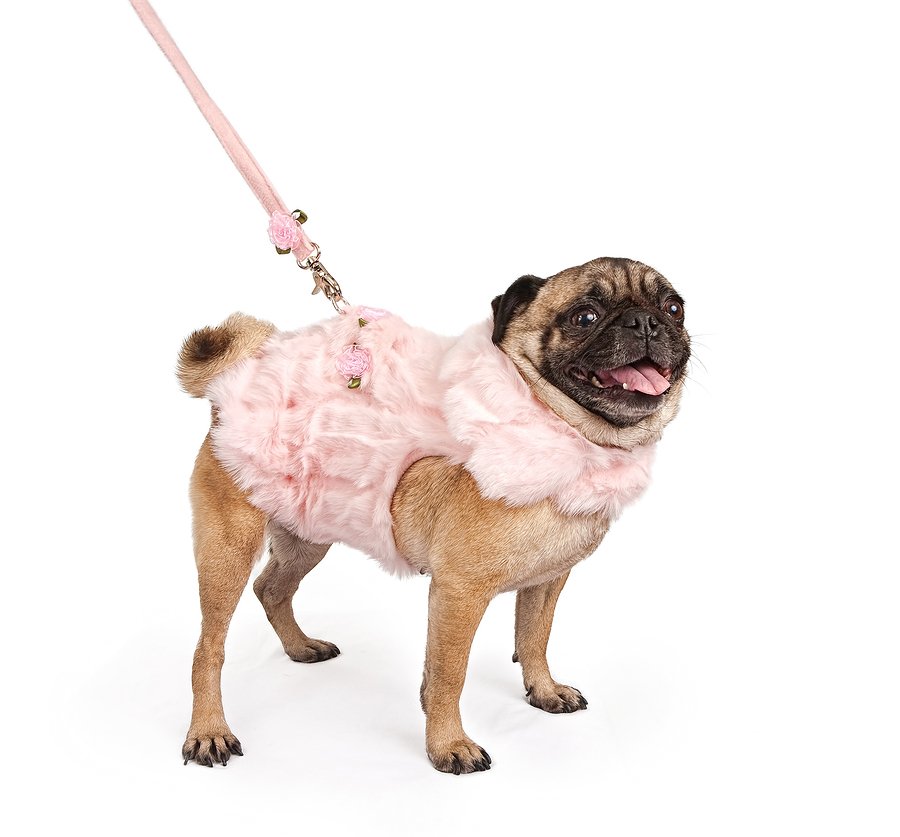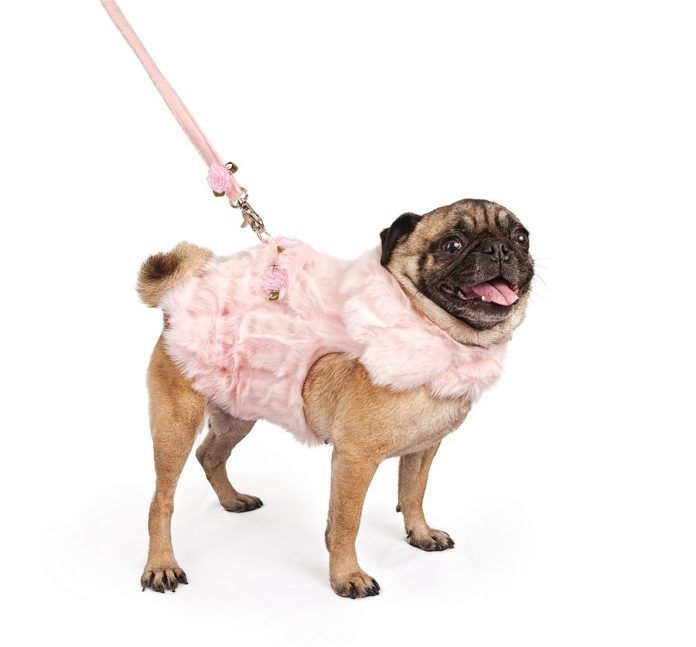“I can’t tell you how many people come in with shock collars and prong collars and don’t feel good about themselves,” says Stephanie Borns-Weil, DVM, who helps owners and their dogs with comportment issues at the Tufts Animal Behavior Clinic. “They know they’re creating fear,” she says, “not respect and love. It hurts at both ends of the leash. You get a dog for a strong bond, but” shocking or digging prongs of metal into your pet “is not compatible with creating a strong bond. Choke and prong collars can actually do tissue damage,” she adds.
“I wonder if some dogs trained with punishment have something akin to canine Stockholm Syndrome,” Dr. Borns-Weil comments. “They can’t escape. They can’t get away — they feel terrorized. But they do experience moments of kindness amidst all the fear in their daily lives. It looks like love — but isn’t. That’s why I prefer collars and leads that really do generate love and trust.”
The right kinds of devices that attach you to your dog
“The punishing collars tell a dog what he can’t do,” says Dr. Borns-Weil. “But with the right device, you can show a dog what to do. They come to understand what you like, what works, and it makes things nice between the two of you.”


BIGSTOCK
Is there any way out of teaching a dog to deal with a collar and lead? No. Every single dog must become acclimated. Even if you live on a remote farm, your pet at some point is going to have to walk in a town with you and behave civilly. That is, your dog is going to need to walk with you — not drag you along as if you’re Olive Oyl and not keep you rooted to a single spot because there’s a blade of grass that he feels he must sniff for an hour. You also want to be able to control him should he decide it would be a good idea to jump up on someone, bother another dog passing in the opposite direction, or try to run from you to chase an intriguing squirrel.
Some dogs are not at all bothered by collars or leashes. They take to them naturally, and quickly. Others, especially as puppies, may need you to attach a leash to their collar and let it drag for a day or two, until you finally pick up the other end of the lead and initially follow the puppy around rather than vice versa. That is, sometimes you have to gradually phase in who is supposed to be walking whom. It’s not second nature for all dogs, so you can’t just attach the collar and lead and go.
To which type of collar should you acclimate your pet?
Buckle collar
Traditionally, the lead, or leash, is attached to a basic flat nylon or leather collar, also called a buckle collar. It’s the one most everybody is familiar with. We don’t recommend it for physical control, although it can be used for training as long as it is used properly and gently.
The main thing, says Dr. Borns-Weil, is that “it takes much patience.” You give a cue like “let’s go,” which means “walk along with a loose leash.” If the dog starts to pull, you stop and hold your ground until the pulling ceases. When the leash is no longer taut, you continue walking again and praise your pet. “It can take a long time to get around the block while training,” comments Dr. Borns-Weil, “but it does work to teach the dog that you move forward only when there is a slack leash. You can amplify the message by praising your dog and giving him food treats when he walks close to you without pulling. Some people help their dogs get the hang of it with clicker training.
It should be noted that a buckle collar is not the way to go for pugs and other brachycephalic (short-nosed) dogs, who have narrow airways, and toy dogs, who are prone to tracheal collapse. (The trachea is the windpipe, which allows the passage of air from the voice box to the lungs.) For such dogs, it can cause real harm.
A buckle collar will also not be the right bet with a dog — particularly a strong dog — who needs more “communication” from you, and may need it very quickly, say, if he’s inclined to snap at or even bite other dogs, or people. Fortunately, there are other excellent options.
Head halter
Unlike buckle collars, which can cause a very determined dog to choke and gag if he’s bent on going where you don’t want him to and is engaged with you in a leash tug of war, a head halter doesn’t require your brute strength. It never gets pulled hard and therefore never causes a dog any discomfort, or pain. Instead, it uses sensitive areas on the dog’s head and nape to send gentle but firm messages without causing any harm.
“Head halters can be broken down into three basic categories,” Dr. Borns-Weil says. People often use the brand name “Gentle Leader” to refer to a head halter, “but that’s like saying ‘Kleenex’ for tissues,” she points out. There are several kinds.
1. Head halters such as the Gentle Leader are made of two soft, adjustable nylon straps with a clip under the chin. One of the straps goes around the nose, and the other rides high on the neck, just behind a dog’s ears — in front of his throat rather than under it. The aim is to keep the neck strap snug, with barely enough room to fit your pinky under it.
The nose strap sits at the base of the muzzle, close to the dog’s eyes — at the bridge of his nose. You have to keep it loose enough so that the dog can eat, drink, or pant with it on.
To be honest, it is not completely clear why the head halter works, but it does. It may be that it mimics the pressure a mother dog might apply to areas that are innately sensitized to receive signals of rebuke or relaxation. When you gently pull upward on the leash, the neck strap tenses, and perhaps that delivers a message like the one a puppy’s mother sends when she picks up her young one by the scruff of the neck to lead or transport him. The puppy instinctively relaxes and is prepared to be led.
At the same time, gentle pressure exerted around the puppy’s muzzle via the nose band conveys the same kind of firm but gentle rebuke, just like Mama would have done it, as the theory goes. That is, a head halter, perhaps by providing pressure at biologically sensitive areas, signals a dog to calm down and reminds him who’s in charge. No jerking of the collar, and no pain, is involved (and no injuries have ever been reported to us).
Sometimes your application of tension to the head halter won’t even be necessary to get your point across. Let’s say, for instance, that your dog tries to walk ahead of you rather than at your side. Stand still. He can’t pull when you make like a tree. The tension on the nose strap will automatically cause his head to turn and make him look up at you. And in that situation, your dog must walk back to you or at least wait until you catch up with him so that the tension is released with some slack and he can resume forward progress. He won’t be able to struggle.
If your dog is lagging behind, the tension will be delivered to his nape via the neck strap. In that case, to release the tension, the dog has to catch up with you.
This type of head halter provides maximum control, sending a constant message to the dog that you’re connected to him and calling the shots. “And it provides the most safety for dogs that have issues with biting,” Dr. Borns-Weil says, “because you have the head end secured. That’s true for all head halters, but this type maintains a level of constant pressure. I myself had a dog who wouldn’t go out without his Gentle Leader. He was fearful. I think it was like his umbilical cord. It made him feel attached to me — and safe.”
2. For dogs who can’t tolerate the slight, constant pressure, there are head halters such as the Snoot Loop and the Halti that hang more loosely. There is no clip underneath and no clip to hold the nose piece. “They don’t help a dog remember that you’re there,” Dr. Borns-Weil says, “but they do give biological input — just not as intensively, although they’re good for not letting the dog pull you and for correcting the head when it gets to close to another dog, or person. You can still turn your dog’s head away and down quickly in case there’s risk of him biting. It directs the head from underneath. It’s good for a dog who every minute tries to scrape the other kind of head halter strap off his nose. Some dogs are particularly sensitive about their snout.”
3. While snoot loops operate by tightening from the back of the head, Canny collars tighten only across the nose. They tend to be a little easier for people to use than the other two types of head halters, but they’re not as effective. “They’ll work to stop pulling and jumping,” Dr. Borns-Weil explains, “but not so well if you have a really aggressive dog who’s out of control. Because you’re pulling from the back and it’s tightening only over the nose, you’re not really able to move the head from side to side. But it does improve your ability to communicate with your dog over a flat buckle collar.”
Of course, it’s best to adjust your dog to a head halter when he’s still a puppy. It’ll be easier if that’s all he knows. About half of all puppies take head halters in stride. Some sulk. They can be jollied out of their bad mood with treats and praise. Hold a good-tasting treat right in front of his nose so that he will get to thinking about —and enjoying — something rather than focusing on being unhappy about the head halter.
Other puppies don’t sulk but struggle willfully to free themselves. If your dog is like that, apply steady upward tension on the leash so he gets the correct signals of control, and say “Stoppit,” calmly. Maintain the tension until he relinquishes his struggle. It could take 10 to 20 seconds the first time — or longer. That’s okay. As soon as the dog gives up, release the tension and… you know the drill. Give lots of praise along with a delectable food treat. He’ll get the deal after a few times.
Note: If you’re trying to acclimate a head halter to an adult dog, there’s a good chance you’re going to get much more resistance. If a dog has had a buckle collar for years and has been successful at pulling you hither and beyond, he may not take kindly to this new apparatus that more firmly makes you, not him, the leader. Start, as you would with a puppy, for only five minutes at a stretch. Small sessions will lead to more manageable longer ones. You’ll be glad you put in the time.
“It’s always a little more challenging with an adult dog because it’s something weird and different for him,” Dr. Borns-Weil says. “I use food treats to get a dog to put his face into it. It might take a couple of weeks. Then they start rushing over to get their face in so they’ll get their treat, then maybe another one. Then, because you’ve put the head halter on, you’re going out for a walk, having fun, throwing a ball.” That is, the head halter becomes associated with happy together time.
Body harness
Some dogs are not going to be able to wear a head halter. They simply don’t have the nose for it. Think of a pug or other brachycephalic breed. There’s not enough nose for the nylon strap to go around.
In such cases, we recommend a body harness. A body harness will not apply pressure to biologically sensitive areas, as a head halter is theorized to do. But it can still be used to deliver a meaningful message. Moreover, it is well tolerated by most dogs and can definitely work better than traditional buckle collars and leads.
There are three types of harnesses:
1. One where the leash clips on the back between the shoulder blades, which applies pressure to the front of the shoulders and thereby gives the dog a message to slow down.
2. One where the leash clips on the front at the chest (examples are the Sense-ation and the Gentle Leader No-Pull harness), so the tension, or pressure, is applied around the chest when you pull up on the lead — and then released when the dog does what you want.
3. One that acts as a combination model, with a leash clip on the chest and also on the back (such as the Freedom No Pull harness).
If the issue is simply avoiding putting pressure on the neck, any of these types of harnesses will work. For a dog who pulls, a harness that attaches the leash at the chest is a better choice, while a harness with the leash attachment at the back can be used to communicate with a dog in a way that is similar to the head halter. But it does not secure the head, “so it is not recommended for biting dogs,” Dr. Borns-Weil says.
Dr. Borns-Weil very much likes the Freedom No Pull harness. “You hold it in the middle by a sliding handle,” she explains. “It gives you the advantage of both of the other types of harnesses. That makes it easier to steer your dog out of harm’s way, from left to right, rather like the reins of a horse. If you (gently)pull the right side of the leash, it pulls your dog to the right; pull to the left, and your dog goes left. It seems to re-set some dogs, stops them in their tracks from lunging or trying to bite, and then you can get going.” But, she notes, “it does take practice to get the hang of all you can do with it.”
“If you have a car chaser,” says Dr. Borns-Weil, “it’s like a firm hand on the chest, the way you’d put your hand on the shoulder of a tantrumming child. Just through that touch you can sometimes communicate with your dog while he’s in what I call the ‘red zone.’ I’ve done it with dog after dog here at Tufts at the busy roadside. With each succeeding car, you tell them they’re a good dog as you release the tension and let the leash go slack. So in their head, they’re aligning the praise with the release of tension. Then they get a food treat, and they connect it all.”
If a body harness is in your future, it’s important to recognize that they’re harder to get the hang of than head halters. You may need a few sessions with a trainer to help you use one properly. But once you and your short-nosed dog get the hang of it, you’ll never look back.
But whether head halter or body harness, Dr. Borns-Weil says that “it’s all based on the principle of using these tools to be able to control your dog for his own sake in a benign way — as well as for the sake of other people or dogs. These devices are really ways of communicating with dogs without punishment. So much of dogs’ inability to do right comes from not knowing what to do. These are wonderful teaching devices.”





